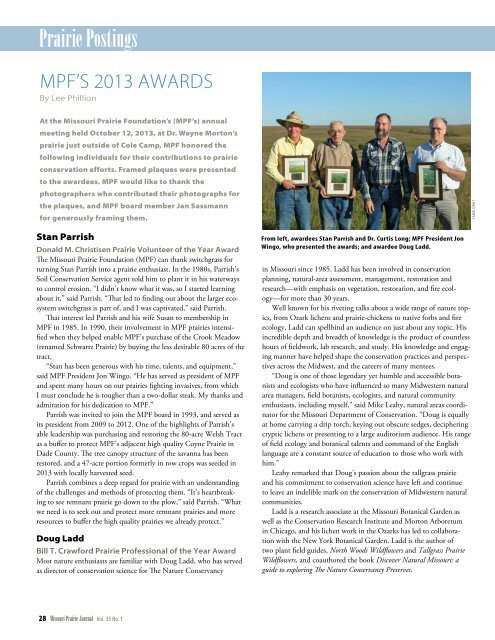l4c9lj6
l4c9lj6
l4c9lj6
Create successful ePaper yourself
Turn your PDF publications into a flip-book with our unique Google optimized e-Paper software.
Prairie Postings<br />
MPF’s 2013 Awards<br />
By Lee Phillion<br />
At the Missouri Prairie Foundation’s (MPF’s) annual<br />
meeting held October 12, 2013, at Dr. Wayne Morton’s<br />
prairie just outside of Cole Camp, MPF honored the<br />
following individuals for their contributions to prairie<br />
conservation efforts. Framed plaques were presented<br />
to the awardees. MPF would like to thank the<br />
photographers who contributed their photographs for<br />
the plaques, and MPF board member Jan Sassmann<br />
for generously framing them.<br />
Stan Parrish<br />
Donald M. Christisen Prairie Volunteer of the Year Award<br />
The Missouri Prairie Foundation (MPF) can thank switchgrass for<br />
turning Stan Parrish into a prairie enthusiast. In the 1980s, Parrish’s<br />
Soil Conservation Service agent told him to plant it in his waterways<br />
to control erosion. “I didn’t know what it was, so I started learning<br />
about it,” said Parrish. “That led to finding out about the larger ecosystem<br />
switchgrass is part of, and I was captivated,” said Parrish.<br />
That interest led Parrish and his wife Susan to membership in<br />
MPF in 1985. In 1990, their involvement in MPF prairies intensified<br />
when they helped enable MPF’s purchase of the Crook Meadow<br />
(renamed Schwartz Prairie) by buying the less desirable 80 acres of the<br />
tract.<br />
“Stan has been generous with his time, talents, and equipment,”<br />
said MPF President Jon Wingo. “He has served as president of MPF<br />
and spent many hours on our prairies fighting invasives, from which<br />
I must conclude he is tougher than a two-dollar steak. My thanks and<br />
admiration for his dedication to MPF.”<br />
Parrish was invited to join the MPF board in 1993, and served as<br />
its president from 2009 to 2012. One of the highlights of Parrish’s<br />
able leadership was purchasing and restoring the 80-acre Welsh Tract<br />
as a buffer to protect MPF’s adjacent high quality Coyne Prairie in<br />
Dade County. The tree canopy structure of the savanna has been<br />
restored, and a 47-acre portion formerly in row crops was seeded in<br />
2013 with locally harvested seed.<br />
Parrish combines a deep regard for prairie with an understanding<br />
of the challenges and methods of protecting them. “It’s heartbreaking<br />
to see remnant prairie go down to the plow,” said Parrish. “What<br />
we need is to seek out and protect more remnant prairies and more<br />
resources to buffer the high quality prairies we already protect.”<br />
Doug Ladd<br />
Bill T. Crawford Prairie Professional of the Year Award<br />
Most nature enthusiasts are familiar with Doug Ladd, who has served<br />
as director of conservation science for The Nature Conservancy<br />
From left, awardees Stan Parrish and Dr. Curtis Long; MPF President Jon<br />
Wingo, who presented the awards; and awardee Doug Ladd.<br />
in Missouri since 1985. Ladd has been involved in conservation<br />
planning, natural-area assessment, management, restoration and<br />
research—with emphasis on vegetation, restoration, and fire ecology—for<br />
more than 30 years.<br />
Well known for his riveting talks about a wide range of nature topics,<br />
from Ozark lichens and prairie-chickens to native forbs and fire<br />
ecology, Ladd can spellbind an audience on just about any topic. His<br />
incredible depth and breadth of knowledge is the product of countless<br />
hours of fieldwork, lab research, and study. His knowledge and engaging<br />
manner have helped shape the conservation practices and perspectives<br />
across the Midwest, and the careers of many mentees.<br />
“Doug is one of those legendary yet humble and accessible botanists<br />
and ecologists who have influenced so many Midwestern natural<br />
area managers, field botanists, ecologists, and natural community<br />
enthusiasts, including myself,” said Mike Leahy, natural areas coordinator<br />
for the Missouri Department of Conservation. “Doug is equally<br />
at home carrying a drip torch, keying out obscure sedges, deciphering<br />
cryptic lichens or presenting to a large auditorium audience. His range<br />
of field ecology and botanical talents and command of the English<br />
language are a constant source of education to those who work with<br />
him.”<br />
Leahy remarked that Doug’s passion about the tallgrass prairie<br />
and his commitment to conservation science have left and continue<br />
to leave an indelible mark on the conservation of Midwestern natural<br />
communities.<br />
Ladd is a research associate at the Missouri Botanical Garden as<br />
well as the Conservation Research Institute and Morton Arboretum<br />
in Chicago, and his lichen work in the Ozarks has led to collaboration<br />
with the New York Botanical Garden. Ladd is the author of<br />
two plant field guides, North Woods Wildflowers and Tallgrass Prairie<br />
Wildflowers, and coauthored the book Discover Natural Missouri: a<br />
guide to exploring The Nature Conservancy Preserves.<br />
Carol Davit<br />
28 Missouri Prairie Journal Vol. 35 No. 1


